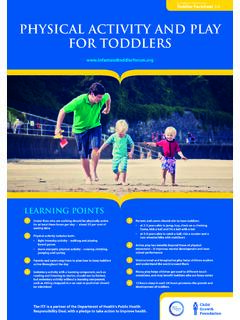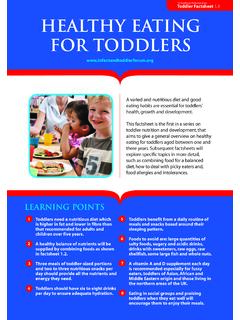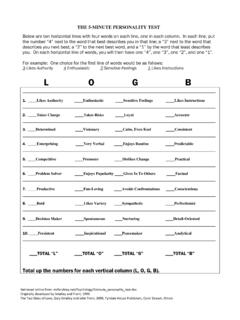Transcription of DEVELOPMENTAL STAGES IN INFANT AND TODDLER …
1 For Healthcare Professional useToddler Factsheet STAGES IN INFANT AND TODDLER LEARNING POINTS1 Four key areas in the development of feeding are the acquisition of: skills related to feeding and eating specific feeding skills taste, texture and food preferences appetite regulation2 General skills include facial expressions, holding and mouthing, imitating others behaviour and relating to others3 Specific feeding skills include sucking, swallowing, chewing, biting, spoon-feeding and drinking from a cup4 Taste, texture and food preferences develop as children learn to accept or reject certain food tastes and textures5 Appetite regulation begins from birth but becomes more effective as the child learns to signal hunger and satiety 6 There is considerable variation in the ages at which infants and toddlers achieve new feeding skills due to.
2 Differences in the rate of their physical and mental development interaction with the environment how often these skills are promoted by the parent02 DEVELOPMENTAL STAGES IN INFANT AND TODDLER FEEDING03 Parents often ask health professionals when their child can be expected to attain feeding and drinking related skills and acquire preferences for particular foods. They also want to know if it is normal for their child to be reluctant to accept certain tastes, and which food textures they can cope with at what ages. Feeding infants and toddlers can be an intense and emotional (positive and negative) experience for both parent and child. During the early years a child s relationship with food, during milk-feeding, the introduction of complementary foods and the transition to family foods, can be critical for his or her health and development, and have long-term factsheet aims to provide health and childcare professionals with an evidence-based description of the DEVELOPMENTAL STAGES observed around food and feeding in infants and young children.
3 The factsheet is divided into four sections, dealing with the development of: skills related to feeding and eating specific feeding skills taste, texture and food preferences appetite regulationDevelopmental milestones can be helpful markers of typical child development and used to reassure parents about their child s development. However, the age at which infants achieve many motor skills is dependent on how often they are promoted by the parent and performed by the child. This means that there is variation in the ages at which an INFANT or TODDLER will achieve a new skill, determined by his or her innate abilities and interaction with the - 1 month1 month - 3 months3 months - 6 months6 months - 12 months12 months - 2 years2 years and aboveKeyThe DEVELOPMENTAL STAGES are illustrated using the colour coding key related to feeding and eatingThere are a number of general motor skills and behavioural changes which, while not specific to feeding, play an important part in the development of an INFANT s eating habits and ability to eat food and drink.
4 Recognising the body language, facial expressions and physical behaviour of infants and toddlers can greatly assist parents and carers in feeding and mouthingFrom three months an INFANT can use both tongue and mouth to explore toys and by four months hold, mouth and look carefully at objects1,2. Objects cannot be picked up with a thumb and finger (pincer grasp) until about nine months of without supportAbout one-third of infants can sit alone without support between the ages of four to six months, and by nine to eleven months almost all infants (97 per cent) can do this4, at objectsThis can occur in infants as young as nine months, but most toddlers will begin to point by 14 months to show others what they want6, and from this age they may point at foods that they know or objects by sightGrouping foods into visual categories begins from about nine months of age7.
5 For example, as children progress into their second year and move from local to global processing they begin to understand that a new, different-shaped biscuit might taste like a biscuit that they have had first wordsSome infants say their first word at nine months, and most will have done so by eighteen months8. At first these words are not generalised, but context-specific; toddlers begin saying no , more or naming a food that they want at mealtimes from around 12 hand to mouth and opens mouth in preparation to suck2 monthsHolds objects3 monthsHolds onto objects and puts them into the mouth4 monthsHolds, mouths and shows visual exploration of objects4 - 11 monthsBegins to sit with some support and then unaided9 monthsPincer grasp with finger and thumbSits without supportMOTOR DEVELOPMENT AND COGNITIVE DEVELOPMENT OF FEEDING SKILLS9 - 18 monthsSays first words, context specific, might say word for known food12 monthsRecognises food by sight.
6 Smell and taste Communicates using words to ask for or name foods that they might want 12 months and beyondVisually groups food into categories05 BirthIndicates likes and dislikes3 - 5 monthsTells the difference between others expressions of pleasure and disgust7 monthsPrefers a smile to a frown 10 monthsUses facial expressions (of others) as a cue to change behaviourFacial expression4 - 6 monthsSome imitation of movements and facial expressionBirthImitates adult facial expressionOpens mouth in response to adult open mouth6 months - 2 yearsShows deferred imitation of action which is not context specific2 yearsImitates other toddlers behaviourImitation of OthersNewborn infants can signal their taste preference by facial expression. They will grimace in response to tastes they dislike , such as a bitter taste. Sweet foods do not elicit this adverse ability to recognise different adult facial expressions is achieved by some infants between three and five months10.
7 However, it is not until seven months that infants interpret emotional cues and prefer to look at a smiling rather than a frowning face11; and it is not until around ten months of age that most infants change their behaviour in response to different adult facial monthsWatches and responds appropriately to a sequence of events in interactions with othersBirthPrefers to look at facesInteraction with othersInfants are interested in faces from birth, and by the age of four months will watch and understand turn-taking interactions with others13. They become attuned to the style of feeding that they have experienced. If mealtimes are stressful they can pick up on this at an early infants can show basic imitation of face and mouth movements from birth14. From soon after birth, they show motor movements in response to other peoples actions and these gradually become more like the movement that they are trying to copy.
8 However, such imitation is still poor, even at six months of age3, and it takes many repetitions for infants to achieve good mimicry. Good imitation of adult behaviour develops through the second year of life15. 14-month old toddlers imitate eating behaviour and will try a new food if an adult tries it first. Toddlers start imitating other toddlers from around 24 months and children of three to four years of age will modify their food choices to be like those of other children with whom they are eating16,17, and swallowingSucking and swallowing are observed in fetuses in the womb as early as 14 - 15 weeks gestation. The smooth co-ordination of sucking, breathing and swallowing develops in infants over the first few days of life19. Newborn infants can only cope initially with sucking liquids because the space within the mouth is very small and tongue movement therefore limited.
9 They can adapt their sucking response to adjust to different types of milk flow, milk from the breast or the bottle19. Newborn infants can open their mouth in readiness to suck their fist. This behaviour is more likely to happen if the INFANT is gag reflexThe gag reflex in newborn infants is a protective reflex that prevents the ingestion of pieces of food that are too large to be comfortably swallowed20. Lumpy foods are best started early to promote good oral motor function, at around six months21,22. As the INFANT gets more used to foods and other textures in the mouth, the gag reflex usually declines. However, it can still be seen in infants of six months and older when they are given lumpy solid foods21. The gag reflex in response to solid textured foods gradually declines between the ages of six to twelve months, and is seen less often in infants who have begun to eat lumpy foods from an earlier age.
10 Lumpy solid foods are usually introduced between around five and 15 months1. Highly sensitive children, who find touch in the mouth uncomfortable may gag and then vomit as an aversive response to lumpy foods23. The gag response does not disappear completely; many adults gag in response to oral controlMoving food appropriately to the back of the mouth can be observed from as early as two months of age1. If pureed or smooth foods are introduced between four and six months, when the INFANT is learning to control the tongue, some tongue protrusion occurs which can look as if the INFANT is pushing the food out of the mouth. This does not mean the INFANT dislikes the food, but needs more practice with it in order to develop tongue movementA newborn INFANT can move the tongue up and down within the mouth, and in and out of the mouth, but the oral cavity is too small for anything other than liquid19.














